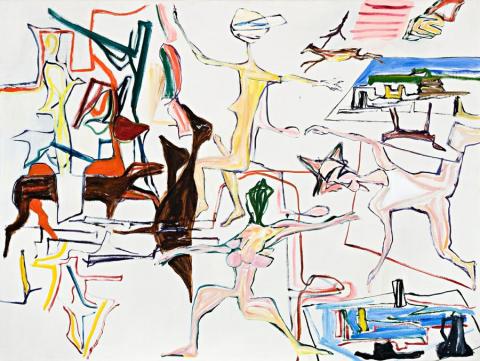OPEN AIR CIRCUS WITH GERMANIC HERMAPHRODITE AND BROWN DUCKS, 1983-87
Ken Whisson
oil on canvas
89.5 x 119.0 cm
signed, dated and inscribed verso: Ken Whisson /“Open Air Circus with / Germanic Hermaphrodite /and Brown Ducks” / painted: 26/10/83 /& 6/2/84 & 23/12/87
Watters Gallery, Sydney
Private collection, Melbourne, acquired from the above in 1998
Discussing the small group of 'circus paintings' such as the present Open Air Circus with Germanic Hermaphrodite and Brown Ducks, 1983-87, which Whisson executed around 1983 in Perugia, Bernice Murphy elaborates '...There are recollections here of visit to Morocco in 1969 - in particular, Marrakech. In Marrakech, Whisson experienced some of the most striking contrasts he had ever encountered to the social environment of his youth in Australia. The differences presented themselves in a vivid series of images, colours and sounds: of a maze of small streets; of the movements of clowns, jugglers, musicians and dancers performing daily in a square in the old city.
More recently, Whisson had been entranced by seeing the Imaginary Circus troupe perform during a trip to London - acts involving dazzling transformations of humans into gigantic insects, employing huge umbrellas and fans. These experiences also called to mind Max Ernst's fantastic metamorphoses - for instance, The Chinese Nightingale (a collage of 1920). Having done some drawings in crayons and pastels while in England, Whisson moved into a series of paintings involving circus motifs when he returned to Perugia.
Apart from metamorphic imagery and memories of actual performances (including a Chinese troupe of magicians and acrobats who visited Italy), the circus paintings are contemporary with Whisson's reactions to the Geneva Conference in Europe at the time - mostly towards the end of 1983.
'...I was thinking about atomic war so much, and nuclear war. Europe was very conscious of it because the Geneva Conference was so obviously a farce, so obviously a front for putting new missiles into Europe... I had the feeling there wouldn't be anything to paint anymore, but nuclear annihilation.. I took to thinking what sort of world it might be... what human relations would need to be, if people were going to relate in such a way that they didn't have to bring about wars... Now that we [would] all live together as an enormous human family across the whole globe, we might need to relate together by entertaining one another. I though of the world as a great circus - societies, or cities, or towns, or streets... And these people would relate to one another as they do in my street in Perugia, Corso Garibaldi...[which] I'm inclined to think of these days as a village. New cities and new buildings don't seem to be environments for communal and social living. I was trying to think in these terms - how will we be able to relate? Perhaps we'll have to relate to one another as clowns and acrobats and entertainers if we're going to live together as human beings.'1
1. Murphy, B., 'Ken Whisson: The Juggler and the Labyrinth' in Ken Whisson: Paintings 1957-1985, The Broken Hill City Art Gallery, New South Wales, 1985, pp. 20-21
VERONICA ANGELATOS
